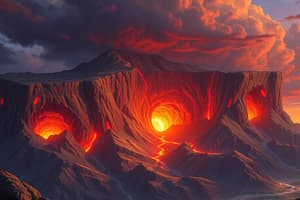Podcast
Questions and Answers
Define the epicenter and hypocenter of an earthquake.
Define the epicenter and hypocenter of an earthquake.
The epicenter is the point on the Earth's surface directly above the hypocenter, which is the point where the earthquake originates.
Explain how a seismograph works to record an earthquake.
Explain how a seismograph works to record an earthquake.
Seismographs detect slight earth vibrations, causing a suspended mass to remain at rest while the ground moves, recording the difference.
Recognize the arrival of P, S surface and aftershocks on a seismogram and explain why their arrival is staggered.
Recognize the arrival of P, S surface and aftershocks on a seismogram and explain why their arrival is staggered.
P, S, and surface waves arrive at different times due to their varying speeds; P waves are fastest, followed by S waves, and then surface waves.
Explain how P and S arrival times can be used to calculate the epicenter of an earthquake using the P-S interval from three seismic stations.
Explain how P and S arrival times can be used to calculate the epicenter of an earthquake using the P-S interval from three seismic stations.
Describe and name the advantages and disadvantages of the Mercalli, Richter, and Moment Magnitude scales.
Describe and name the advantages and disadvantages of the Mercalli, Richter, and Moment Magnitude scales.
Explain how a tsunami forms.
Explain how a tsunami forms.
Compare a tsunami to a normal ocean wave in terms of wave speed, period, and length.
Compare a tsunami to a normal ocean wave in terms of wave speed, period, and length.
Describe our ability to make long and short term earthquake predictions.
Describe our ability to make long and short term earthquake predictions.
Flashcards are hidden until you start studying
Study Notes
Earthquake Terminology
- Epicenter: Point on Earth's surface directly above the hypocenter, where the earthquake originates.
- Hypocenter (Focus): The actual location within the Earth where an earthquake starts, marking the rupture point.
Seismograph Functionality
- Mechanism: Detects slight earth vibrations. A suspended mass remains at rest, leading to differential motion recorded by a stylus.
- Types:
- Horizontal Seismograph: Moves in the horizontal plane.
- Vertical Seismograph: Uses a spring to absorb some motion, causing the mass to lag and record accurately.
Seismogram Arrival Times
- P Waves: Primary waves that arrive first due to their faster speed.
- S Waves: Secondary waves that arrive after P waves, slower in comparison.
- Surface Waves: Arrive after S waves, typically resulting in greater surface damage.
- Aftershocks: Smaller tremors following the main quake, adding to staggered occurrence on seismograms.
Epicenter Calculation
- P-S Interval Method: By measuring the time difference between P and S wave arrivals at three different seismic stations, the epicenter's location can be accurately calculated.
Magnitude Scales
- Mercalli Scale: Measures earthquake intensity based on observed effects and damage; subjective and varies with location.
- Richter Scale: Quantifies earthquake magnitude based on seismic wave amplitude; logarithmic scale.
- Moment Magnitude Scale: Provides a more accurate measure of total energy released; considers fault size, slip, and rock rigidity.
Tsunami Formation
- Causes: Typically generated by underwater earthquakes, volcanic eruptions, or landslides that displace water, creating large wave energy.
Tsunami vs. Ocean Waves
- Speed: Tsunamis travel significantly faster than normal ocean waves, often exceeding 500 km/h.
- Period: Tsunamis have longer wave periods, often ranging from minutes to hours compared to seconds for regular waves.
- Length: Tsunamis have much longer wavelengths that may exceed hundreds of kilometers.
Earthquake Prediction
- Short-term Predictions: Currently limited ability to predict exact timing and location, generally based on observational data.
- Long-term Predictions: More reliable through geological studies and historical records, estimating probabilities of future quakes over extended periods.
Studying That Suits You
Use AI to generate personalized quizzes and flashcards to suit your learning preferences.




